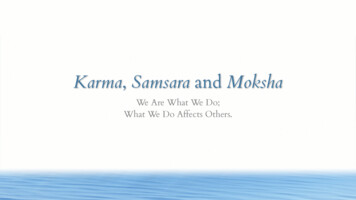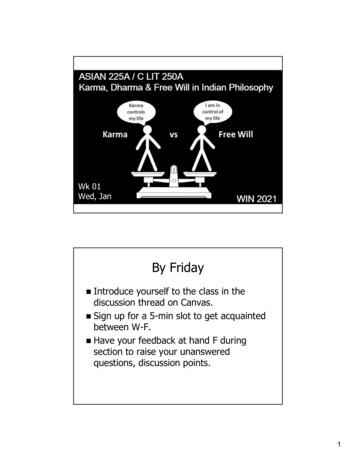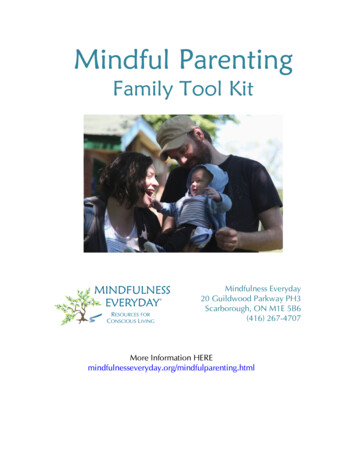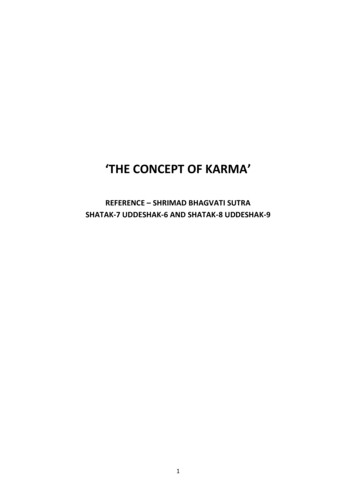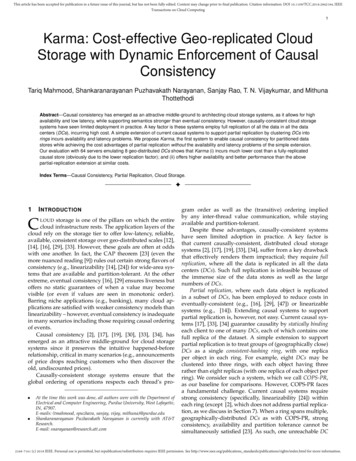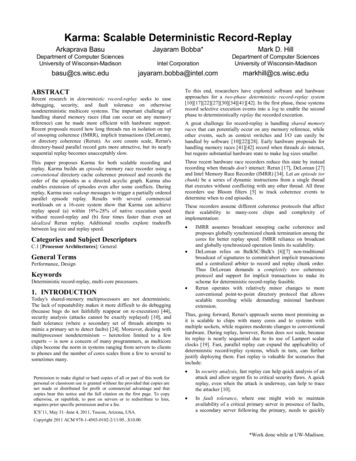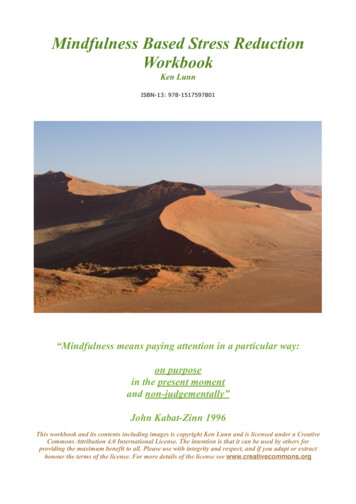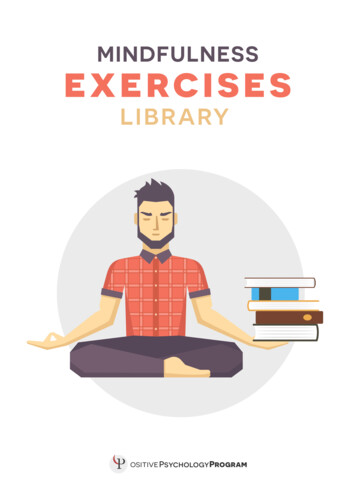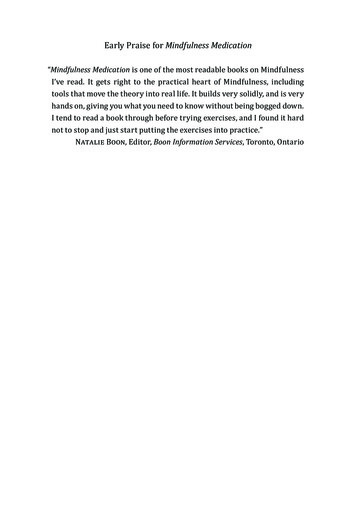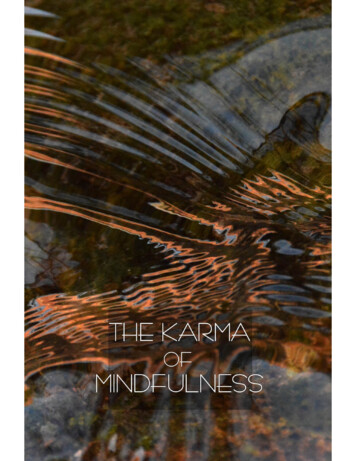
Transcription
The Karma of MindfulnessT H E B U DDH A’S T EACH I NG SON SAT I & K AMMAṬhānissaro Bhikkhu(Geoffrey DeGraff )2
“Just as a royal frontier fortress has a gatekeeper, wise,experienced, intelligent to keep out those he doesn’t know and tolet in those he does know, for the protection of those within and toward off those without, in the same way a disciple of the nobleones is mindful, endowed with excellent proficiency inmindfulness, remembering and recollecting what was done andsaid a long time ago. With mindfulness as his gatekeeper, thedisciple of the noble ones abandons what is unskillful, developswhat is skillful, abandons what is blameworthy, develops what isblameless, and looks after himself with purity.”— AN 7:633
co pyright 2015 ṭhānissaro bhikkhuThis work is licensed under the Creative Commons Attribution-NonCommercial4.0 Unported. To see a copy of this license /. “Commercial” shall mean anysale, whether for commercial or non-profit purposes or entities.questio ns ab o ut this b o o k may b e addresse d toMetta Forest MonasteryValley Center, CA 92082-1409U.S.A.additio nal reso urcesMore Dhamma talks, books and translations by Ṭhānissaro Bhikkhu areavailable to download in digital audio and various ebook formats atdhammatalks.org.printe d co pyA paperback copy of this book is available free of charge. To request one, writeto: Book Request, Metta Forest Monastery, PO Box 1409, Valley Center, CA92082 USA.4
PrefaceIn May of this year, members of Le Refuge, a Buddhist group located in Auriol,near Marseilles, invited me to lead an eight-day retreat on the topics of kamma(karma) and mindfulness (sati). The retreat provided me with the opportunity todiscuss the relationships between these two central Buddhist concepts, to showhow the Buddha’s teachings on kamma—far from being irrelevant to the practiceof mindfulness—actually provide the essential grounding for understanding howmindfulness best functions in developing the mind for the purpose of putting anend to suffering and stress.The talks of the retreat were presented in three series: a series of morning talkson mindfulness, a series of evening talks on kamma, and a series of afternoon talkson issues arising in meditation that are best understood in light of the Buddha’steachings on both kamma and mindfulness. As the retreat progressed, the threeseries of talks converged.The present book is based on all three series of talks, presented chronologically,along with some of the questions submitted by people attending the retreat, whichhave been reordered and placed after the talks to which they seem most clearlyrelated. The talks, the questions, and the answers to the questions have been editedand expanded so as to make their coverage of both main topics of the retreat morecomplete than I was able to manage on the spot.The talks draw on suttas, or discourses, from the Pāli Canon and on the writingsand talks of the ajaans, or teachers, of the Thai forest tradition, in which I wastrained. For people unfamiliar with the Canon, I have added passages from thediscourses at the back of the book to flesh out some of the points made in the talks.These are followed by a glossary of Pāli terms.For people unfamiliar with the Thai forest tradition, you should know that it isa meditation tradition founded in the late nineteenth and early twentieth centuryby Ajaan Mun Bhūridatto. The ajaans mentioned in the talks trained under him. Ofthese, Ajaan Fuang Jotiko and Ajaan Suwat Suvaco were my teachers. Ajaan Fuang,although he spent some time training directly under Ajaan Mun, spent more timetraining under one of Ajaan Mun’s students, Ajaan Lee Dhammadharo.Many people have helped with the preparation of this book. In particular, Iwould like to thank the people of Le Refuge who made the retreat possible, and5
Claude LeNinan, my excellent and meticulous interpreter throughout my stay insouthern France. Here at Metta, the monks at the monastery helped in preparingthe manuscript, as did Michael Barber, Linda Harter, Addie Onsanit, and IsabellaTrauttmansdorff. Any mistakes in the book, of course, are my own responsibility.Ṭhānissaro Bhikkhu(Geoffrey DeGraff)Metta Forest MonasteryO c t o b e r, 2 0 1 56
AbbreviationsANDNMNSNAṅguttara NikāyaDīgha NikāyaMajjhima NikāyaSaṁyutta NikāyaReferences to DN and MN are to discourse (sutta); those toAN and SN are to section (nipāta, saṁyutta) and discourse.Numbering for AN and SN follows the Thai Edition of the PāliCanon.All translations from these texts are by the author and arebased on the Royal Thai Edition of the Pāli Canon (Bangkok:Mahāmakut Rājavidyālaya, 1982).7
DAY O N E : E V E N I N GIntroductionMay 17, 2015Good evening, and welcome to our retreat on the themes of mindfulness andkamma.We’re here this week to learn some useful skills to deal with one of the mostfundamental problems in life, which is that we all desire happiness, we keep actingon the desire for happiness, and yet we often cause suffering for ourselves andothers through our own actions. The Buddha, after his awakening, focused hisenergies on helping us solve precisely this problem. As he analyzed it, he saw thatthere’s nothing wrong with desiring happiness. We simply don’t approach thatdesire with enough wisdom.One of the most basic principles of wisdom is that we need to train our minds.You may have noticed that you can be living in good conditions and yet still suffer,and that you can be happy in spite of bad conditions. Your happiness and sufferingboth depend on the inner condition of your mind. And the Buddha discovered thatthe condition of your mind doesn’t have to be a random thing or left to chance. Itcan be trained through your own efforts. But your efforts have to be guided bywisdom. Two of the most important concepts that the Buddha used in hisinstructions on how to develop wisdom are mindfulness and kamma.Unfortunately, these two concepts are often misunderstood. Kamma ismisunderstood and, in the West, is generally disliked. Mindfulness is somethingthat everybody likes even though they don’t understand it properly. So this weekwill be devoted to understanding these two concepts and the relationship betweenthem so that we can get the most use out of them.The concept of kamma is usually disliked because people believe it to bedeterministic, teaching that your present experience is controlled by your pastkamma, which is something you’re powerless to change. But as the Buddha pointedout, your present experience is shaped not only by past kamma but also by presentkamma. In fact, your present kamma is more important than your past kamma indetermining whether or not you suffer in the present. Present kamma deals withthe way you shape your experience in the present moment. We are active beings,not passive. The mind takes an active and proactive role in shaping its experience8
from moment to moment.It’s like fixing food. Our past kamma is like raw food, and our present kamma islike the act of fixing the food so that we can eat it. In fact, feeding is one of thecentral images in the Buddha’s teachings: Because we are beings, we need to feedboth physically and mentally. To feed properly, we need to know how to fix ourfood well.Another reason why people don’t like the idea of kamma—especially whenconnected with rebirth—is that they see that it’s something that can’t be proven,and so they’d rather just put the whole issue aside. But the question of how far theconsequences of your actions go isn’t something that can be put aside. Every timewe act, whether we’re conscious of it or not, we’re calculating the balance betweenthe effort put into the action and the results we expect to receive. And as we makethese calculations, we’re making assumptions about the future that can’t be proven:Do we have free will? Will our actions affect only this life, or will they go on intothe next?In presenting his teaching on kamma, the Buddha is giving us a set ofassumptions—or working hypotheses—that will explain why it makes sense tofollow a path to the end of suffering, and that will encourage us to act skillfully inall situations. We won’t know that these assumptions are actually true until wereach the first level of awakening, but we will see that these assumptions make usbetter, more responsible people in the meantime. Of course, some people wouldrather not make the effort to be more responsible, but the Buddha wasn’t interestedin teaching them.A third reason why people don’t like the idea of kamma is because they assumethat the Buddha simply picked up the idea of kamma, unthinkingly, from whateveryone in India believed at the time. This is not true. The questions of whetherpeople actually are responsible for their actions, or kamma, and whether theiractions actually shaped their experience, were hotly debated in the Buddha’s time.And the Buddha had a very distinctive way of explaining kamma, unlike anythingelse that had been taught in India—or anywhere else.Two principles in his teaching on kamma were especially distinctive. The first isthat kamma is intention [§4]. In other words, action is not simply a matter of themotion of the body. It’s a matter of the mind—and the intention that drives thekamma makes the difference between good actions and bad.The second distinctive principle is that kamma coming from the past has to beshaped by kamma in the present before you can experience it. You actuallyexperience your present kamma before you engage with the results of past kamma.Without present kamma, you wouldn’t experience the results of past kamma at all.The importance of your present kamma is the reason why we meditate. When we9
meditate, we’re getting more sensitive to what we’re doing in the present moment,we’re creating good kamma in the present moment, and we’re learning how to bemore skillful in creating good kamma all the time, from now into the future.Now, in learning to shape our present moment skillfully, it helps to learnlessons from other people who have learned through experience how to shape theirkamma skillfully themselves. We also have to learn from our own actions,observing what we do and the results of what we do. Once we’ve learned thoselessons, we have to remember them. If we learn them and then forget them, they’reuseless.It’s for this reason we need to develop mindfulness, or sati, which the Buddhadefined as a faculty of memory: your active memory, the lessons you need toremember from the past about how to shape your experience skillfully in thepresent. There are people who explain mindfulness as bare attention or fullawareness, but the Buddha wasn’t one of them. In his use of the term, mindfulnessis your active memory, your ability to keep things in mind. So, as we discussmindfulness in the course of this retreat, try to keep the Buddha’s meaning of theword in mind.To practice right mindfulness, you combine mindfulness with two otherqualities: sampajañña, which is to be alert to what you’re doing right now and tothe results you’re getting from your actions; and ardency, ātappa, which meansputting your whole heart into doing it well. You need to bring all three qualitiestogether as you meditate so that your practice of mindfulness will be right, and willstrengthen the next factor in the path: right concentration, samādhi.As we meditate, we actually develop mindfulness together with concentration.Some people say that mindfulness practice is one thing; concentration is somethingelse. But again, the Buddha was not one of those people. Mindfulness andconcentration have to work together. Without mindfulness you can’t rememberwhere to stay concentrated. Without concentration, your mindfulness gets veryfuzzy and forgotten. So this week we will be learning to put mindfulness andconcentration together, and also to bring kamma into the mix, because mindfulnessand concentration are things we intentionally do. You can’t understand themproperly or do them properly without understanding the principles of kamma.You have to remember that you’re fixing food for the mind all the time: eachtime you breathe in, each time you breathe out. We tend to forget this, though,because we’re too intent on wanting to gobble down our experiences, whenever wecan find them. We forget the lessons we’ve learned from the past. So we have toremember that we’re here fixing food for the present moment, and we want to eatwell. How we do this will also influence what we experience in the future.10
Ultimately, we want to bring the mind to a place where it’s so strong that it doesn’tneed to feed anymore at all.This means that both mindfulness and kamma make reference to all three timeframes. Mindfulness brings in what you’ve learned from the past and reminds youto focus on shaping things well in the present moment so that it will also have agood effect in the future. In the same way, the results of your past intentions comein from the past, providing the raw material for the food in the present; and as youfix that food in the present, it will have an influence on the food available to youwell into the future.This further means that the teachings on mindfulness and kamma worktogether. In fact, they’re inseparable. You can’t understand right mindfulnesswithout understanding kamma, and you can’t develop skillful kamma for thepurpose of release without developing right mindfulness.That’s the main lesson of the retreat. If you’re in a hurry to leave and go home,you can leave now because you’ve learned the basic lesson. But to learn it as a skillwill take some time. That’s why we’re here for a week—and why the retreat isbeing recorded, so that you can take the lessons home and continue working onthem after the week is up.My teacher used to recommend not teaching people until they had meditated. Ifthey haven’t meditated, they won’t understand anything. So the first step inlearning about mindfulness and kamma will be to meditate now. That way you’llhave some hands-on experience in focusing on your present kamma and indeveloping the three qualities of mindfulness, alertness, and ardency.GU I DED MEDI TAT IONGet in a comfortable position. Sit up comfortably straight, place your hands inyour lap, face forward, and close your eyes.Think thoughts of goodwill. Goodwill is a wish for happiness—a wish for truehappiness, both for yourself and for other people. When we wish goodwill forourselves and for others, we’re basically wishing that we and other people willunderstand the causes for true happiness and act on them. And this is a thoughtyou can spread to anyone, even people who are doing unskillful things, veryunskillful things, creating a lot of damage to the world. You’re basically wishingthat they will stop and have a change of heart, which means that goodwill issomething that you can spread to everyone without hypocrisy.We think these thoughts at the beginning of the meditation because truehappiness comes from within. It comes from developing the good potentials of themind through the skills we master in meditation. This is why there’s no conflict11
between your true happiness and anyone else’s true happiness. So when you posethe thought in your mind, “May I be happy,” it’s not a selfish thought. The moreyou’re able to develop your own inner skills, the more you will have to offer toother people as well. This is why goodwill can be developed as an unlimitedattitude.So pose that thought in your mind for a few minutes: “May I be truly happy.May I come to understand the causes of true happiness. And may I be able to act onthem.”Now spread the same thought to others. Start with people who are close to yourheart: to members of your family, and to very close friends. May they find truehappiness, too.Then spread the same thought out in ever-widening circles:to people you know well and like,to people you like even though you don’t know them so well,to people you’re more neutral about,and to people you don’t like.Remember that the world would be a much better place if everyone could findtrue happiness inside.Spread thoughts of goodwill to people you don’t even know. And not justpeople: living beings of all kinds, in all directions—east, west, north, south, above,and below, out to infinity. May we all find true happiness in our hearts.Now bring your attention to the breath. The word “breath” here doesn’t meanjust the air coming in and out of the lungs. It also means the flow of energythroughout the body, which exists on many levels. On the most obvious level, it’sthe flow of energy that allows the air to come in and go out of the lungs. But it alsoincludes the flow of energy in the nerves and the blood vessels, out to every pore.So take a couple of good long, deep in-and-out breaths and notice where youfeel the breath energy. If long breathing feels good, keep it up. If it doesn’t feelgood, you can change the breath. There are two ways of changing it. One is toconsciously experiment with different kinds of breathing: long, short, fast, slow,deep, shallow, heavy, light, or any combination of those. Try various ways ofbreathing to see what feels best for the body right now. When you’ve found arhythm and texture of breathing that feels good, stick with it for as long as itcontinues to feel good. If the needs of the body change, then allow the breath tochange in line with them. Try to be as sensitive as you can to learn the signs in thebody indicating what way of breathing will serve it best.The other way to change the breath is to consciously pose the question in yourmind, each time you breathe in: “What would feel really good right now?” And see12
how the body responds on its own.If any thoughts not related to the breath grab your attention, just drop them andyou’ll be right back at the breath. If the mind goes wandering off 10 times, 100times, bring it back 10 times, 100 times. Don’t get discouraged. Just keep letting thethoughts go, letting them go. And you don’t have to chase them away. Even thougha thought unrelated to the breath may appear in the mind, you can still feel thebreath. Stay with that sensation.Each time you return to the breath, reward yourself with an especiallygratifying breath. That way the mind will be more and more inclined to keepcoming back to the breath and more willing to stay there.If there are any pains in the body, don’t focus on them. Focus instead on theopposite side of the body. In other words, if there’s a pain in the back, focus on thefront of the torso. If pain on the right, focus on the left.When the breath gets comfortable, there’s a danger that you might start leavingthe breath to follow the comfort, but that will destroy the foundation for the senseof comfort, which is your continued focus on the breath.So to counteract that tendency, the next step is to breathe in and out aware ofthe entire body. And the first step in that direction is to survey the sensations ofthe breath in the different parts of the body, section by section.Start down around the navel. Locate that part of the body in your awareness.Watch it for a while as you breathe in and breathe out to see what kind ofbreathing feels good there. If there’s any tension or tightness there, allow it to relaxand dissolve away, so that no new tension builds up as you breathe in, and youdon’t hold on to any tension as you breathe out. If it helps in dissolving the tension,think of the breath energy entering and leaving your body right at the spot whereyou’re focused, so you don’t have to create tension by trying to pull energy fromanywhere else in the body. As the patterns of tension begin to dissolve away, try tonotice if there are any more subtle patterns of tension, and allow those to dissolveaway as well.Now move your attention over to the right, to the lower right hand corner ofthe abdomen, and follow the same steps there. One, locate that part of the body inyour awareness. Two, watch it for a while as you breathe in and breathe out to seewhat kind of breathing feels good there. And three, if there’s any sense of tensionor tightness there, allow it to relax.Now move your attention over to the left, to the lower left hand corner of theabdomen, and follow the same three steps there.Now bring your attention up to the solar plexus, right at the tip of thebreastbone, and follow the same three steps there.13
Now bring your attention over to the right, to the right flank.And then to the left, to the left flank.Then bring your attention to the middle of the chest. Try to be especiallysensitive to how the breath energy feels around the heart, and breathe in a waythat feels soothing there.Now bring your attention to the right, to the place where the chest and theshoulder meet.And then to the same spot on the left.Now bring your attention to the base of the throat.Now bring your attention to the middle of the head. As you breathe in and out,think of the breath energy coming in and out of the head from all directions, notonly through the nose, but also through the eyes, the ears, in from the back of thehead, down from the top of the head, going deep, deep, deep into the brain, gentlydissolving away any patterns of tension you may feel anywhere in the head:around the jaws, around the forehead, around the eyes, at the back of the neck.Now bring your attention to the base of the neck, right at the base of the skull.As you breathe in, think of the breath energy entering there from the back andspreading down through the neck, down the shoulders, the arms, out to the tips ofthe fingers. As you breathe out, think of it radiating out from all those parts of thebody into the air.As you get more sensitive to these parts of the body, if you see that one side isholding more tension than the other, relax that side and try to keep it relaxed, allthe way through the in-breath, all the way through the out.And as obvious patterns of tension begin to relax in these parts of the body, tryto become more sensitive to detect subtler patterns of tension that were obscuredby the more obvious ones. Allow even the slightest tension that you can detect torelax.Now, keeping your attention focused on the back of the neck, this time as youbreathe in think of the energy entering there and then going down both sides of thespine all the way down to the tailbone. Then as you breathe out, think of itradiating out from the entire spine into the air. And again, if you notice that there’smore tension in one side of the back than the other, allow that side to relax. Andtry to keep becoming more and more sensitive even to the slightest patterns oftension in this part of the body. When you sense them, allow them to relax.Now bring your attention down to the tailbone. As you breathe in, think of theenergy entering there and going down through the hips, the legs, to the tips of thetoes. And then as you breathe out, think of the energy radiating out from all thoseparts of the body into the air. And again, if there’s more tension in one side of the14
body than the other, allow that side to relax. And keep it relaxed, all the waythrough the in-breath, all the way through the out. As you’re staying here, try tobecome sensitive to ever more and more subtle patterns of tension so that you candissolve those away, too.That completes one cycle of the survey of the body. If you want, you can gothrough the body again to pick out any patterns of tension you may have missedthe first time around. Keep this up until you’re ready to settle down.Then choose any one spot in the body that seems most congenial or mostinteresting. Allow your attention to settle there and then to spread out to fill thewhole body, so that you’re aware of the whole body breathing in, the whole bodybreathing out. As your awareness spreads, think of it as exerting no pressure at allon your body. It’s like the light of a candle in an otherwise dark room: The flame isin one spot, but the light fills the entire room. Or like the spider in the middle of aweb: The spider is in one spot, but it’s sensitive to the whole web. Try to maintainthis sense of centered but broad awareness all the way through the in-breath, allthe way through the out. Maintain this quality of awareness as long and as steadilyas you can. Try to master it as a skill. Your attention will have a tendency to shrink,especially during the out-breath, so each time you breathe in and out remindyourself, “Whole body, whole body.” Allow the breath to find whatever rhythmfeels best. Your duty is simply to maintain this centered but broad awareness.There’s nowhere else you have to go right now, nothing else you have to do,nothing else you have to think about. This awareness is healing for the body andhealing for the mind. It’s like a medicinal cream for curing a rash on your skin. Forit to work, you have to leave the cream on the skin. If you put it on and then wipeit off, it can’t have any effect. This is why it’s good to develop this type ofawareness for a long time. Because it’s still and all-around, it’s a good foundationfor insight to arise. But don’t worry about the next step in the meditation, or whenthe insights will arise. They’ll arise as this quality of awareness matures. Righthere. Give it time.(Meditation)Before leaving meditation, remember that there are three steps to leavingproperly.The first is to ask yourself, “At what point in the meditation was the mindespecially well-centered, still, and comfortable? Especially clear?” Then askyourself, “Where were you focused at that point? What was your breath like? Whathad you been doing leading up to that point?” If you can remember these things,try to keep them in mind and see if you can apply them to the next time youmeditate, to recreate the same conditions and get the same results. Now it mayhappen that you don’t get the same results, but that simply means that you need to15
be more observant the next time around. Gradually you’ll become more adept atnoticing what’s worth paying attention to, and what’s not. It’s in this way that themeditation becomes a skill.That’s the first step.The second step is to think of whatever sense of peace or wellbeing you’ve feltduring this session and dedicate it to others, either to specific people you know aresuffering right now or to all living beings in all directions: May we all find peaceand wellbeing in our hearts.The third step is to remember that even though you open your eyes, you canstill be aware of the breath energy in the body, as you get up, walk around,whatever you do: Try to stay as fully aware of this breath energy as continually asyou can. It may be asking too much to try to focus on the in-breath and the outbreath all the time, but just try to be aware of the quality of the breath energy inthe body, and release any patterns of tension that you may detect, as soon as theyarise, in the course of the day. This way you provide yourself with a goodfoundation for observing your mind as you go through the day. It also provides youwith a sense of being grounded in your daily activities. This helps build up themomentum of your practice.See if you can maintain this full body awareness until the next time that you sitdown to meditate. That way, the next time you sit down to focus on the breath,you’ll be right there.It’s like keeping a dog on a short leash. When you want it to come, it’s rightthere. Otherwise, if you drop your awareness of the breath energy, it’s like keepingyour dog on a very long leash. It will wrap the leash around other people’s legs,lampposts, trees—all kinds of things. When you want it to come back, you’ll haveto unwind the leash, which takes a very long time. So try to maintain thisawareness of the breath energy as part of your whole day.And with that thought, you can open your eyes.Q: To be mindful, does this mean to be aware of your words, your acts, andtheir consequences?A: No, mindfulness, or sati, is the ability to keep in mind what you should bedoing. Developing alertness, sampajañña, means being clearly aware of youractions, your words, your thoughts, and their consequences, for the purpose ofdoing things skillfully. Vigilance or heedfulness is your motivation for wanting tobe both mindful and alert.16
Q: When you are in mindfulness, are you remembering and by this act solicitingthe past, or are you firmly in the present?A: With mindfulness, you are trying to bring only what you need to know fromthe past. Through the quality of alertness, you focus on the present. Try to bringthe two of them together, so that you remember what you need to know from thepast so as to shape the present moment well. Remember, too, that the present is notjust given to you. It’s also something that you’re shaping in the present moment aswell. Past kamma gives you the potentials for the present moment, but yourpresent kamma is actually what shapes your experience from those potentials.Q: Can we bring together mindfulness and “what knows” within us?A: “What knows” within us is basically our awareness. That’s present all thetime. Mindfulness is the ability to remember. It’s not always there or may be in thewrong place, which is why we have to train it. As for alertness, that’s particularlyfocused on our actions and their results. So in that way, alertness gives more focusto “what knows” inside.Q: If you are being mindful when involved in an activity that completelyabsorbs you, when all thoughts go away, can this be created in the case of tossing asalad or also in the work of a sculptor or musician?A: When you are totally absorbed in your action, that is called alertness. Butthere should also be somewhere in the back of your mind the question: What is theskillful way to do this? That would be mindfulness. And the effort to followthrough with what is skillful would be ardency.Q: Does there exist a right mindfulness and wrong mindfulness or goodmindfulness and bad mindfulness?A: Yes, you can have either good or bad mindfulness. An example of wrongmindfulness i
on mindfulness, a series of evening talks on kamma, and a series of afternoon talks on issues arising in meditation that are best understood in light of the Buddha’s teachings on both kamma and mindfulness. As the retreat progressed, the three series of talks converged. The present book

